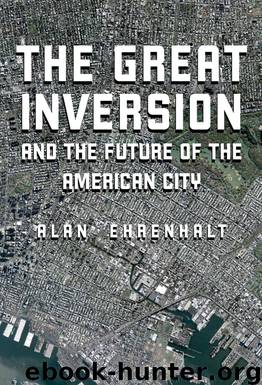The Great Inversion by Alan Ehrenhalt

Author:Alan Ehrenhalt [Ehrenhalt, Alan]
Language: eng
Format: epub
ISBN: 9780307957405
Publisher: Knopf Doubleday Publishing Group
Published: 2012-04-23T14:00:00+00:00
CHAPTER SIX
UNEASY COEXISTENCE
TWO NOTABLE EVENTS TOOK PLACE in Philadelphia in late February 2009. They had nothing to do with each other, but taken together, they suggest why Philadelphia offers many hints about the American city of the future—and presents so many obstacles to its realization.
One of the events was the opening of a spectacular new Cézanne exhibit at the city’s major art museum. In honor of the exhibit, three gourmet restaurants in or near Center City announced that they were creating special menus that featured dishes from the artist’s native Provence. One of the restaurants, Zinc, offered squid flash-seared with Pernod, and apple pastry in lavender caramel sauce for dessert.
On the night those dishes were being introduced at Zinc, a somber ritual was being enacted eight miles north on Broad Street. Some three hundred police were marching in columns four abreast from Archbishop Ryan High School to the Givnish Funeral Home on Academy Road in northeast Philadelphia. They were marching to honor fellow policeman John Pawlowski, murdered six days earlier by a thief who had accosted a taxi driver. Pawlowski was the fifth police officer in the city to be killed in the line of duty in just one year.
It is hard to know exactly what to make of such a place. There are cities in America, such as Boston, Chicago, and New York, that are, despite serious problems, glamorous and exciting and a magnet for tourists from all over the world. Others, such as Detroit, are so badly blighted that it is hard to imagine anyone wanting to visit them. Somehow, Philadelphia manages to be both those things at once. Its residents sometimes refer to it jokingly as Bostroit—a city that is healthy on the inside and decaying badly on the periphery.
To say that Center City is healthy may actually be to understate the case a little bit. A four-block walk down Walnut Street, from the Bellevue hotel at Broad Street to Rittenhouse Square at Eighteenth, is a stroll past amenities comparable to those of Michigan Avenue or Fifth Avenue, but on a much less intimidating scale. Walnut Street is not a canyon. It’s a collection of low-slung century-old buildings with ground-floor retail that oozes wealth: Tiffany, Burberry, Godiva, Ralph Lauren; a sprinkling of spas and luxury salons; and an assortment of restaurants offering haute cuisine. One can take in the shops, stop to sip a Bacardi mojito at the sidewalk café outside Alma de Cuba, then order truffle-stuffed lamb loin with sweetbread tempura at Le Bec-Fin, the most elegant restaurant in town and one of the most famous on the East Coast.
Virtually all the storefronts are occupied: 90 percent of them even in the trough of recession at the end of the last decade. And Walnut Street is not only plush, it is thronged with people throughout the daytime and the evening as well. A 2009 survey found that 2,468 people walked by the corner of Walnut and Sixteenth during the average lunch hour. Precise comparisons to downtown
Download
This site does not store any files on its server. We only index and link to content provided by other sites. Please contact the content providers to delete copyright contents if any and email us, we'll remove relevant links or contents immediately.
The Secret History by Donna Tartt(16617)
The Social Justice Warrior Handbook by Lisa De Pasquale(11489)
Thirteen Reasons Why by Jay Asher(7786)
This Is How You Lose Her by Junot Diaz(5764)
Weapons of Math Destruction by Cathy O'Neil(5034)
Zero to One by Peter Thiel(4823)
The Myth of the Strong Leader by Archie Brown(4789)
Promise Me, Dad by Joe Biden(4444)
Stone's Rules by Roger Stone(4415)
Beartown by Fredrik Backman(4412)
How Democracies Die by Steven Levitsky & Daniel Ziblatt(4396)
The Fire Next Time by James Baldwin(4340)
100 Deadly Skills by Clint Emerson(4075)
A Higher Loyalty: Truth, Lies, and Leadership by James Comey(4031)
Rise and Kill First by Ronen Bergman(4012)
The David Icke Guide to the Global Conspiracy (and how to end it) by David Icke(3880)
The Farm by Tom Rob Smith(3871)
Secrecy World by Jake Bernstein(3782)
The Doomsday Machine by Daniel Ellsberg(3730)
